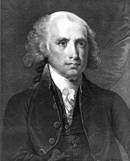| American Government |
|
| Sections: Introduction | Section 1 | Section 2 | Section 3 | Section 4 | Section 5 |
|
Government : Origins : Section Five Creating the Constitution
The failure of the Articles had taught them that a stronger central government was necessary, but most were still apprehensive about creating a government with too much power. They needed to find a balance. The delegates came from all over the country, and they each saw the ways that their state governments were working. Because of their varied background and political experiences, they brought many new ideas to the table. There were many issues that had to be addressed at the convention. Revising the Articles of Confederation would require the agreement of all states. Rather than amend this document, the representatives decided to write a new agreement – a constitution. One of the major issues they had to address related to representation in Congress. Small states supported what is known as the New Jersey Plan. This plan stated that all states would be equally represented in Congress, regardless of size and population. Larger states favored the Virginia Plan. Under this plan, a state’s representation would be based on its population, thus giving larger states more representatives in Congress. A compromise was necessary to create a system that would work for both sides. The Connecticut Compromise (also known as the Great Compromise) stated that Congress would be bicameral, with two houses called the House of Representatives and the Senate. The House of Representatives would have its membership based on population, thus giving more representatives to larger states. The Senate would have equal representation; all states would have two senators regardless of size and population.
Another major issue that came up at the convention was that of slavery. Southern states wanted slaves to be counted toward their population so they could get more representation in the House of Representatives. Northern states were opposed to this idea. The Three-Fifths Compromise created a system in which 3/5s of all slaves would be counted toward the population of states. Because the decision to change the Articles was partially motivated by the economic problems plaguing the nation at the time, issues relating to the economy were of high priority to the delegates. It was decided that Congress would have many economic powers, including the rights to borrow money, tax, regulate business and coin money. Among other powers given to the new Congress by the new Constitution were the powers to declare war, set voting qualifications, and create and maintain a military. The delegates made important decisions relating to many issues of government – they created a national court system, an executive officer in the position of president, and set rules for how the three branches of the new government would prevent each other from abusing their power.  One of the chief authors of the Constitution was James Madison. His idea of government, called the Madisonian Model, laid a plan for how the government would be structured. Madison wanted to establish a republic, rather than a direct democracy. He did not feel that the masses could be trusted to make many of the decisions that a government must make. Madison’s ideas of separation of powers and checks and balances, which will be discussed in more detail in the next unit, are among the most important concepts of the Constitution. It took the delegates many weeks to iron out a plan for the new government, but that was only the beginning. They next had to convince the states to accept the plan and ratify, or approve, the Constitution. Two distinct factions formed – the Federalists and the Antifederalists. The Federalists were a group who supported the new constitution and its federal system of government. They were largely the elite of society, those who were educated and wealthy. A group of Federalists – James Madison, Alexander Hamilton, and John Jay – wrote and published many famous documents called the Federalists Papers. The Federalist Papers were documents written in support of the proposed Constitution, trying to convince people to vote to ratify the document. This series of 85 articles gave a clear analysis of the philosophy behind the Constitution – why things were written the way they were.
Click here to read Federalist 10, which was written by James Madison. The Antifederalists believed that the Constitution was harmful to the lower class. They felt that the document gave too much power to the central government, which would be run by the elite, and took power away from the state governments. They felt this shift in power would harm the individual liberties of American citizens. They went on to argue that a list of rights, that would protect the individual liberties of citizens, must be added to the Constitution. Conceding this point, Federalists promised to add a bill of rights in order to gain support of the Antifederalists, and the ratification of the Constitution.
|
|
© 2007 Aventa Learning. All rights reserved. |